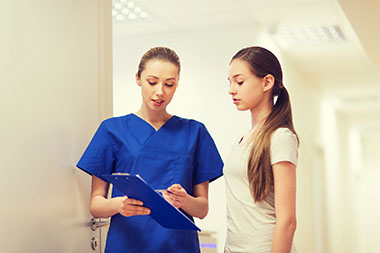Public Health Professor Creates 30-Second Tool to Assess Adolescent Health Literacy
 |
|
The “REALM-TeenS” tool can quickly assess how well teens understand health information.
|
ALBANY, N.Y. (April 19, 2017) – Imagine being released from the hospital with a confusing diagnosis, stacks of papers to read and more questions than answers about what to do next.
That is the reality for a large percentage of American teenagers. Many have a limited ability to obtain, process and understand health information and services presented to them – also known as low health literacy. Yet, adolescent health literacy research remains limited compared with adult populations.
Jennifer Manganello has published a new study in Pediatrics that may be able to help fill the gap.
The study, led by Manganello, an associate professor in the Health Policy, Management & Behavior in the School of Public Health, is a collaborative effort to develop a brief assessment tool which identifies adolescent health literacy limitations in less than 30 seconds. It’s called Rapid Estimate of Adolescent Literacy in Medicine, short form “REALM-TeenS.”
The tool requires adolescents to read 10 health-related words from a list of common health care terminology. For example, “diabetes,” “asthma,” “exercise” and “bronchial.” The concept is that if an individual has difficulty pronouncing these words in isolation, he or she is likely to have difficulty with comprehension.
“Numerous studies have indicated low health literacy is linked to negative health outcomes in adults. However, limited research has been done on adolescents,” Manganello said. “REALM-TeenS offers researchers and clinicians a brief screening tool that can be used to quickly assess adolescent health literacy in a variety of settings."
.jpg) |
|
Jennifer Manganello. (photo by Paul Miller)
|
“REALM-TeenS” is a shorter version of a longer assessment tool “REALM-Teen,” which was developed in 2006 by Terry Davis of the Louisiana State University Health Sciences Center, one of the new study collaborators. The original tool required adolescents to read 66 health-related words in three minutes.
The health literacy scores from the 10-word assessment correlated highly (92 percent) with the 66-word assessment and decision consistency was 80 percent across both forms. The researchers compared data from two sources, including a total of 665 youth aged 12 to 19 years old.
Manganello hopes validation of the shorter approach will give public health researchers and health professionals more incentive to consider measuring health literacy when working with adolescent populations.
“We understand that researchers and health professionals often have a very limited amount of time to ask questions and collect their information. Our new tool makes it easier,” Manganello said. “Identifying low health literacy in adolescents can be useful for tailoring important health information, medication instructions, and follow-up support.”
Davis worked with Manganello on the new “REALM-TeenS” tool. Other researchers involved include Kimberly Colvin, UAlbany School of Education, Deena Chisolm, Nationwide Children’s Hospital, Connie Arnold, Louisiana State University Health Sciences Center and Jill Hancock, Louisiana State University Health Sciences Center.
The team’s research was funded by multiple grants including $165,300 from the National Institutes of Health/National Institute of Child Health and Human Development.
Learn more about Manganello by visiting her University expert profile. You can also follow her on Twitter, @healthcommphd.
![]() For more news, subscribe to UAlbany's RSS headline feeds
For more news, subscribe to UAlbany's RSS headline feeds
A comprehensive public research university, the University at Albany-SUNY offers more than 120 undergraduate majors and minors and 125 master's, doctoral and graduate certificate programs. UAlbany is a leader among all New York State colleges and universities in such diverse fields as atmospheric and environmental sciences, business, education, public health,health sciences, criminal justice, emergency preparedness, engineering and applied sciences, informatics, public administration, social welfare and sociology, taught by an extensive roster of faculty experts. It also offers expanded academic and research opportunities for students through an affiliation with Albany Law School. With a curriculum enhanced by 600 study-abroad opportunities, UAlbany launches great careers.


